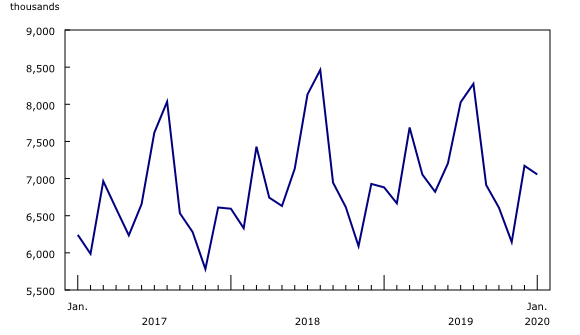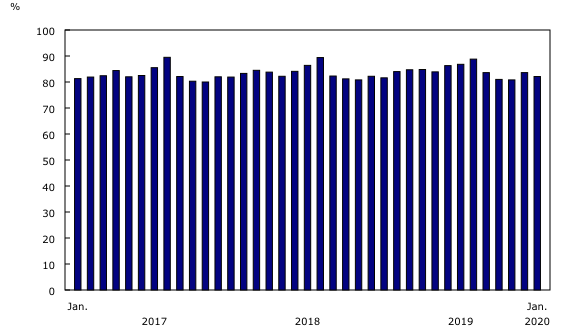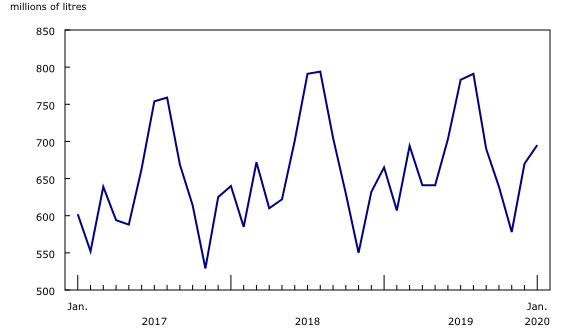Monthly civil aviation statistics, January 2020
Archived Content
Information identified as archived is provided for reference, research or recordkeeping purposes. It is not subject to the Government of Canada Web Standards and has not been altered or updated since it was archived. Please "contact us" to request a format other than those available.
Released: 2020-03-31
The seven Canadian Level I air carriers flew 7.1 million passengers on scheduled and charter services in January, up 2.5% compared with January 2019, when there were six carriers. This follows a 3.5% increase in December 2019 and represents the third year-over-year monthly increase.
The number of air carriers increased from six in 2019 to seven in 2020, as one Level II air carrier was reclassified to Level I.
Traffic grew 2.0% year over year to 18.6 billion passenger-kilometres in January. Capacity rose 1.3% to 22.7 billion available seat-kilometres. This resulted in a higher passenger load factor in January (82.1%) compared with the same month a year earlier (81.6%), as the increase in demand for travel was greater than the rise in capacity.
On average, each passenger travelled 2,643 kilometres, down 0.5% compared with January 2019.
The volume of turbo fuel consumed increased 4.5% to 694.7 million litres, while the number of flying hours edged down 0.5% to 199,000 hours.
Operating revenue for these airlines totalled $2.1 billion in January, up 5.6% from the same month a year earlier.
Possible impacts of COVID-19 on the largest Canadian air carriers
The novel coronavirus (also known as COVID-19) has created an unprecedented crisis in the air transport industry in Canada and around the world. In response to the virus outbreak, the federal government has put in place a series of measures such as travel restrictions and partial border closures. Earlier, Canadian airlines first cancelled or curtailed international services but now some carriers have suspended all flights resulting in large-scale employee layoffs and unpaid leaves.
Canadian airlines employed 46,000 people before the crisis began, according to the National Airlines Council of Canada. WestJet Airlines Ltd. recently announced it would be cutting 6,900 jobs from a work force of about 14,000. Porter Airlines employs 1,500 people and has issued layoff notices to the "vast majority" of them. Air Canada's pilots have agreed to a deal that reduces pay, allows early retirement and includes an option for a maximum of 600 layoffs "if required."
The evolving situation has resulted in drastic operational changes and severe financial challenges for the Canadian airline industry. While the full impact is not reflected in January's report as travel restrictions were initially put in place later in that same month, the financial burden will become clearer in the coming months. The Canadian Airports Council expects the number of passengers to fall by as much as 71% in the March-to-June period. Losses could extend even further into the busy summer travel season.
As carriers continue to curtail operations and lay off employees, it is expected that some will require financial support from the government to help weather this storm. According to the International Air Transport Association—which represents 290 airlines that account for more than 82% of the world's traffic—almost half the world's airlines will run out of cash and fail in the coming weeks unless governments act quickly to bail out the industry.
Note to readers
The Monthly Civil Aviation Survey covers all Canadian Level I air carriers: Air Canada (including Air Canada Rouge), Air Transat, Jazz, Porter, Sky Regional, Sunwing and WestJet (including Swoop, WestJet Encore and WestJet Link).
The average passenger trip length is obtained by dividing the number of passenger-kilometres by the number of passengers. Trips across Canada and across the globe are included in this calculation.
Data in this monthly release are not seasonally adjusted.
Data for January 2019 have been revised.
Contact information
For more information, or to enquire about the concepts, methods or data quality of this release, contact us (toll-free 1-800-263-1136; 514-283-8300; STATCAN.infostats-infostats.STATCAN@canada.ca) or Media Relations (613-951-4636; STATCAN.mediahotline-ligneinfomedias.STATCAN@canada.ca).
- Date modified:





